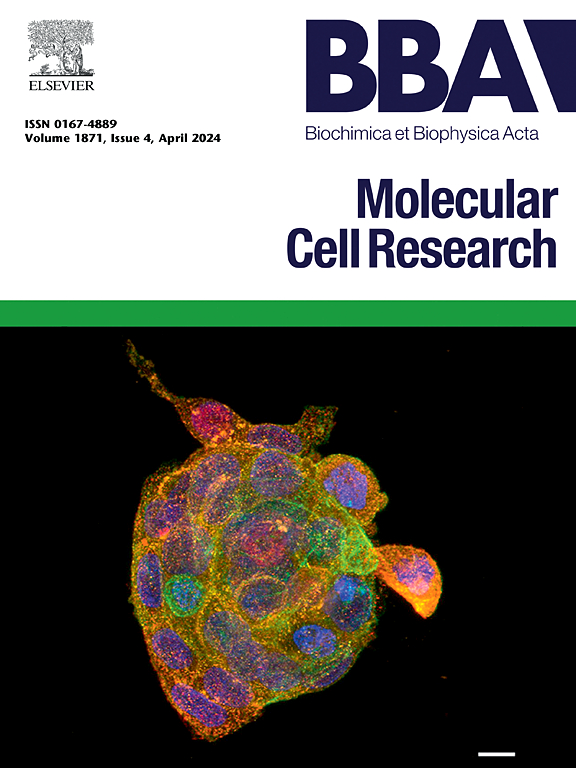Interleukin-2 receptor α (IL-2Rα/CD25) shedding is differentially regulated by N- and O-glycosylation
IF 4.6
2区 生物学
Q1 BIOCHEMISTRY & MOLECULAR BIOLOGY
Biochimica et biophysica acta. Molecular cell research
Pub Date : 2024-10-19
DOI:10.1016/j.bbamcr.2024.119863
引用次数: 0
Abstract
The cytokine interleukin-2 (IL-2) is a critical regulator of immune responses, with an especially well-characterized role in regulating T-cell homeostasis. IL-2 signaling involves three distinct receptor subunits: the IL-2Rα (CD25), IL-2Rβ, and IL-2Rγ. The intracellular transduction of IL-2-induced signals is strictly dependent on IL-2Rβ and IL-2Rγ, while the IL-2Rα is not directly involved in signaling. Instead, it has the highest affinity towards IL-2 and is thus responsible for regulating the affinity of a cell for IL-2. In addition to the membrane-bound IL-2Rα, a soluble form of the receptor (sIL-2Rα) has been described, which is present in the blood of healthy individuals, increased under various pathological conditions, and able to bind IL-2 and thus modulate its function. The sIL-2Rα is generated by proteolytic cleavage of the membrane-bound receptor. Here, we analyze whether glycosylation of the IL-2Rα regulates its proteolysis. We find that constitutive IL-2Rα shedding is affected by glycosylation and discover distinct roles for N- and O-glycosylation. Furthermore, we show that induced shedding by the metalloproteases ADAM10 and ADAM17 is also differentially regulated by distinct types of glycans. Finally, we identify a specific role for an N-glycan at an exosite in ADAM17-mediated proteolysis that does not affect ADAM10, indicating distinct substrate recognition mechanisms. These results further the understanding of the mechanisms leading to sIL-2Rα generation, and thus offer the opportunity to specifically modulate the generation of the soluble receptor.
白细胞介素-2受体α(IL-2Rα/CD25)脱落受N-和O-糖基化的不同调节。
细胞因子白细胞介素-2(IL-2)是免疫反应的关键调节因子,在调节 T 细胞稳态方面的作用尤其明显。IL-2 信号转导涉及三种不同的受体亚基:IL-2Rα(CD25)、IL-2Rβ 和 IL-2Rγ。IL-2 诱导的细胞内信号转导严格依赖于 IL-2Rβ 和 IL-2Rγ,而 IL-2Rα 并不直接参与信号转导。相反,它对 IL-2 的亲和力最高,因此负责调节细胞对 IL-2 的亲和力。除了膜结合型 IL-2Rα,还有一种可溶性形式的受体(sIL-2Rα)被描述出来,这种受体存在于健康人的血液中,在各种病理情况下会增加,能够结合 IL-2,从而调节其功能。sIL-2Rα是由膜结合受体蛋白水解产生的。在这里,我们分析了 IL-2Rα 的糖基化是否会调节其蛋白水解。我们发现组成型 IL-2Rα 脱落受糖基化的影响,并发现 N 型和 O 型糖基化的不同作用。此外,我们还发现金属蛋白酶 ADAM10 和 ADAM17 诱导的脱落也受到不同类型糖基的不同调控。最后,我们发现在 ADAM17 介导的蛋白水解过程中,外切物上的 N-聚糖起着特殊作用,而 ADAM10 却不受影响,这表明它们有不同的底物识别机制。这些结果进一步加深了人们对 sIL-2Rα 生成机制的理解,从而为特异性调节可溶性受体的生成提供了机会。
本文章由计算机程序翻译,如有差异,请以英文原文为准。
求助全文
约1分钟内获得全文
求助全文
来源期刊
CiteScore
10.00
自引率
2.00%
发文量
151
审稿时长
44 days
期刊介绍:
BBA Molecular Cell Research focuses on understanding the mechanisms of cellular processes at the molecular level. These include aspects of cellular signaling, signal transduction, cell cycle, apoptosis, intracellular trafficking, secretory and endocytic pathways, biogenesis of cell organelles, cytoskeletal structures, cellular interactions, cell/tissue differentiation and cellular enzymology. Also included are studies at the interface between Cell Biology and Biophysics which apply for example novel imaging methods for characterizing cellular processes.

 求助内容:
求助内容: 应助结果提醒方式:
应助结果提醒方式:


